People returned to subdivision buried by lava in 1990 — could it happen again?
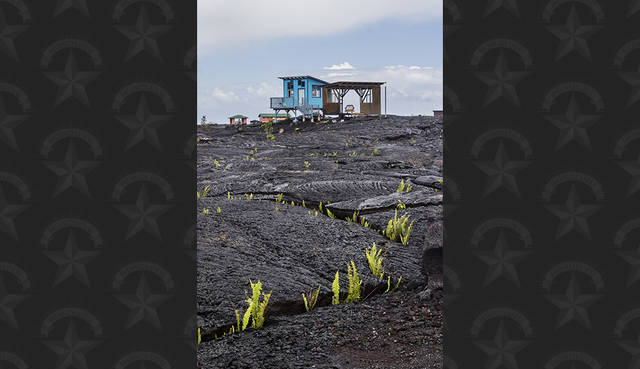
DENNIS ODA / DODA@STARADVERTISER.COM
Above, homes and ferns sprout from the lava on Ala Lokelani Street in Kalapana Gardens.
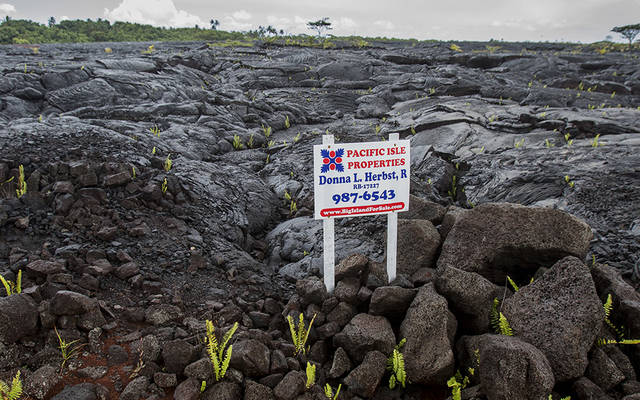
DENNIS ODA / DODA@STARADVERTISER.COM
Above, a sign advertises a vacant lot for sale.
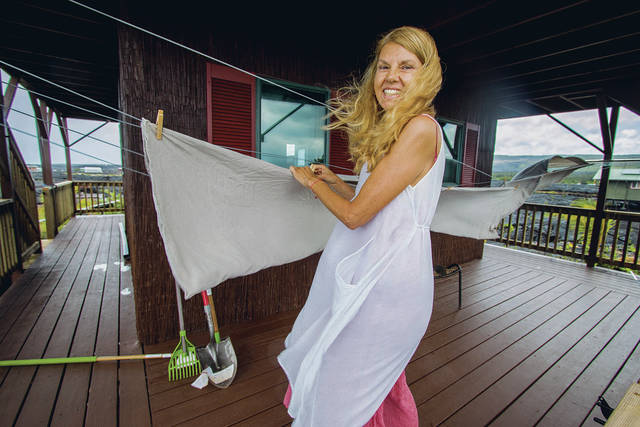
DENNIS ODA / DODA@STARADVERTISER.COM
Resident Pamela Sue hangs sheets in the brisk wind. With no trees to impede it, the wind blows hard and can carry salt spray miles inland.
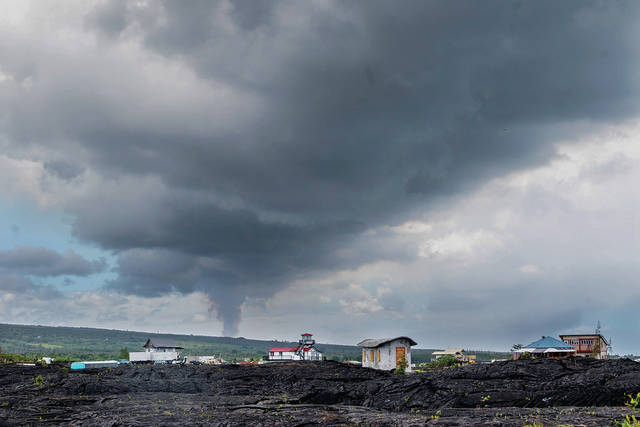
DENNIS ODA / DODA@STARADVERTISER.COM
At top, a huge cloud that spreads over Kalapana Gardens is generated by the current eruption in Leilani Estates. In 1990, a lava flow wiped out a whole subdivision of houses. Since 2004, people have built homes on that lava flow on Ala Lokelani Street.
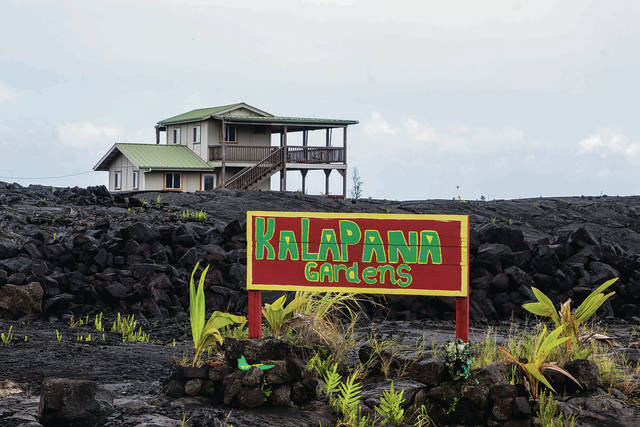
DENNIS ODA / DODA@STARADVERTISER.COM
A hand-painted sign marks the entrance to Kalapana Gardens.





An obituary for the Kalapana Gardens community was written nearly 30 years ago after lava buried the Hawaii island subdivision of 738 house lots and more than 100 homes.
“Kalapana Gardens died this year, burned and smothered by creeping lava from Kilauea Volcano,” read the August 1990 story in The Honolulu Advertiser.
That death notice, however, was premature.
Since about 2004, a sprinkling of adventurous folks have built homes on the rugged lava-scape and Kalapana Gardens has grown to more than 75 homes today.
>> Ban on new construction in lava zones proposed
>> Micro-housing shelters dedicated for displaced Lower Puna residents
>> Leilani Estates evacuees fight through emotions to remove belongings
>> Russian tourist cited for loitering, using drone
>> Hirono pushing for bill that would assist farmers affected by Kilauea eruption
>> Hawai‘i Volcanoes National Park’s future ‘a huge unknown’
RELATED PHOTOS AND VIDEOS
>> Live webcams from Hawaii island
>> Community celebrates Pahoa shelter for lava evacuees, June 30
>> Leilani Estates evacuees say final farewell to homes, June 29
>> Tour of Hawai‘i Volcanoes National Park, June 28
>> Lava river in Leilani Estates, June 23
>> USGS: Fissure 8 channel transports ‘lava boats,’ June 22
Don't miss out on what's happening!
Stay in touch with breaking news, as it happens, conveniently in your email inbox. It's FREE!
COMPLETE KILAUEA COVERAGE
>> Star-Advertiser volcano coverage
>> Kilauea Volcano YouTube playlist
Not many observers expected such rebuilding when Kalapana Gardens was destroyed. Yet now, because of this subdivision’s resurrection, it’s hard not to contemplate whether something similar may be possible for Leilani Estates, Lanipuna Gardens, Vacationland and Kapoho Beach Lots, where more than 600 homes have been consumed by lava that began pouring out of Kilauea’s lower East Rift Zone on May 3.
“Given enough time, people will come back,” predicted David Ewing, owner of the Sirius Coffee Connection cafe in Pahoa, who was among the first to build a home in the new Kalapana Gardens.
There almost certainly will be issues over whether people can rebuild in recently destroyed residential areas, including potential changes in government policy, the insurance market and the evolving landscape.
Other factors sure to play a part in any future resettlement will be economics and lava inundation risks — two considerations that were at the forefront of developing Kalapana Gardens, Leilani Estates and other Puna subdivisions in the first place.
Efforts to create Kalapana Gardens, also known as Kalapana Vacation Lots, began in the late 1950s with an initial investor buying 159 acres west of Kalapana Village where Native Hawaiian families have lived for generations.
The area got designated for resort use, and real estate speculators angled to capitalize on that by selling house lots for relatively little money without much emphasis on volcanic eruption hazards.
Wahiawa-based real estate agent Robert Ishikawa was the first to sell Kalapana Gardens lots after arranging to buy the raw land in 1960, the same year lava destroyed the town of Kapoho about 15 miles away.
Ishikawa promoted lots as a “sound investment” in newspaper ads with no mention of volcanic eruption risks. Parcels of 7,500 square feet or more were priced from $1,485 to $2,385 and could be bought for $385 down plus monthly payments as low as $20.
Ishikawa claimed Kalapana Gardens would be the first major subdivision in the proposed resort area where other development was “virtually assured.” To help lure buyers, Ishikawa offered a free three-day vacation to Las Vegas.
“To boost Kalapana-Hawaii-USA as a future resort area, the ‘good-will’ troupe will be armed with Hawaiian tools of persuasion: flower leis, native fruits, okolehao and lots of hospitality,” said one promotion describing the trip. The Vegas gambit also was supposed to symbolize how investing in a lot was the antithesis of gambling in a casino.
Ishikawa touted in ads and news accounts that about 40 real estate agents had bought parcels ahead of the public, and that about 180 lots were sold in roughly two weeks. The broker estimated roads costing $100,000 would be done within 18 months. Instead, Ishikawa defaulted on his land acquisition.
Not long after that, a developer who helped create the Puna subdivision Nanawale Estates, John Duff, acquired the project with his wife, Ruth, and they put in roads and water lines several years later. Electrical service was provided to only a small part of the subdivision, leaving most lot buyers to rely on generators. No resort was ever built.
All or nearly all the 738 lots were sold over three decades, including many to newcomers from the mainland. However, only a little over 100 homes had been built by the time lava erupted in 1983 from the Puu Oo vent in the middle East Rift Zone and initially threatened the larger Royal Gardens subdivision that also had mostly empty lots about 2 miles from Kalapana Gardens.
Puu Oo erupted in phases with lava that could be little more than a dribble at times or a raging fountain 2,000 feet high. Royal Gardens was wiped out, and the heaviest and final destruction at Kalapana Gardens occurred in 1990.
At the time, and for more than a decade afterward, there wasn’t much prospect of repopulating the area, especially because lava from Puu Oo remained active. Some lot owners even donated their parcels to the county to eliminate a $25 annual property tax on their lava-covered lots that tax assessors valued at $100.
Not until about 15 years later did demand for Kalapana Gardens lots return along with new homes popping up on the rough black landscape.
Between 2005 and 2007, about 20 lot sales ranged from $1,000 to around $20,000, according to property records.
Ewing of Sirius Coffee, who bought his lot for $15,000 in 2006, said the catalyst for the subdivision’s resurrection was the old homeowners association maintenance fund being emptied to carve two roads into the lava field. The new vehicle paths topped by crushed red cinder recreated most of a perimeter road and one bisecting road that re-established access to many but not all lots. About a dozen smaller previous roads remain buried.
Ewing said he and his wife, longtime residents of Lake Tahoe, Calif., were talking to a friend whose wife’s mother owned a Kalapana Gardens lot. “I asked, ‘How much?’ We bought the lot sight unseen. We knew it was on black lava rock. We kind of just jumped on it. We figured after 20 years in Lake Tahoe we don’t need to be cold anymore.”
The couple built their house in 2007, and Ewing said it was the fourth one to go up. He said living on the lava was filled with surreal scenes, including seeing the glowing eyes of spiders at night, watching heavy raindrops bounce a foot or two off the lava rock and feeling the rush of tradewinds uninhibited by trees or other buildings.
More homes in recent years also added to the outlandish look of the new Kalapana Gardens with strange designs and funky color schemes. “The place is kind of bizarre,” Ewing said. “It’s a different world there.”
Then there was the lava. Not the black cold stuff. The red hot liquid kind.
Flows came every now and then toward the subdivision. Ewing said one kept him and his wife up an entire night with dread that their house would be lost. That flow, he said, stopped about 50 yards away.
Ewing said he knew the risk when he bought the lot. But the price for land in Hawaii was too good. “It’s kind of like rolling the dice,” he said. “You hope you don’t get hit.”
More buyers took the same gamble, including 25 this year, and the number of homes is estimated at over 75.
“The secret’s out,” said Adrian Blackhurst, a DJ who moved from Maui to Kalapana Gardens to afford home ownership. “It’s the cheapest land in all of Hawaii — and for a reason. We take the risk.”
Blackhurst, who bought Ewing’s house for $215,000 two years ago, described the new Kalapana Gardens as something that could have been in the post-apocalyptic movie “The Road Warrior” but with a tropical backdrop. “It’s got to be one of the most unique neighborhoods anywhere,” he said. “Like Mad Max goes to Hawaii.”
Allan Reaves built a home at Kalapana Gardens in 2009 and then realized some of the privations that go along with the environment, such as a lack of shade, reduced privacy and uninhibited winds carrying corrosive salt spray far inland.
“Basically it sucks building on lava,” said Reaves, who moved but still owns the home.
Ewing said he decided to leave because the subdivision had lost the seclusion he treasured. He relocated with his wife to a home on an old cinder cone roughly a mile west of Leilani Estates where roads cracked and evacuation was ordered.
Though the couple is staying in a friend’s vacation rental, Ewing vows to return home. “We’re not leaving,” he said. “There’s a magnetic draw to living on a volcano.”




